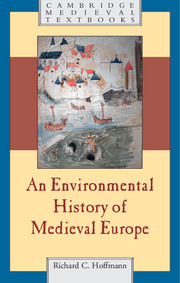Book contents
- Frontmatter
- Contents
- List of figures
- List of maps
- Preface
- Frontispiece: Nature and culture at Waterford, Ireland, 1372
- Introduction: Thinking about medieval Europeans in their natural world
- 1 Long no wilderness
- 2 Intersecting instabilities: culture and nature at medieval beginnings, c.400–900
- 3 Humankind and God’s Creation in medieval minds
- 4 Medieval land use and the formation of traditional European landscapes
- 5 Medieval use, management, and sustainability of local ecosystems, 1: primary biological production sectors
- 6 Medieval Use, management, and sustainability of local ecosystems, 2: interactions with the non-living environment
- 7 ‘This belongs to me . . .’
- 8 Suffering the uncomprehended: disease as a natural agent
- 9 An inconstant planet, seen and unseen, under foot and overhead
- 10 A slow end of medieval environmental relations
- Afterword
- A sampler for further reading
- Index
1 - Long no wilderness
Published online by Cambridge University Press: 05 July 2014
- Frontmatter
- Contents
- List of figures
- List of maps
- Preface
- Frontispiece: Nature and culture at Waterford, Ireland, 1372
- Introduction: Thinking about medieval Europeans in their natural world
- 1 Long no wilderness
- 2 Intersecting instabilities: culture and nature at medieval beginnings, c.400–900
- 3 Humankind and God’s Creation in medieval minds
- 4 Medieval land use and the formation of traditional European landscapes
- 5 Medieval use, management, and sustainability of local ecosystems, 1: primary biological production sectors
- 6 Medieval Use, management, and sustainability of local ecosystems, 2: interactions with the non-living environment
- 7 ‘This belongs to me . . .’
- 8 Suffering the uncomprehended: disease as a natural agent
- 9 An inconstant planet, seen and unseen, under foot and overhead
- 10 A slow end of medieval environmental relations
- Afterword
- A sampler for further reading
- Index
Summary
A long past of continual dynamic changes naturally shaped Holocene (post-glacial) Europe, where medieval history took place. European regions acquired distinct physiographic, climatic, and biological features, but pristine European nature was neither static nor wholly stable.
Nor was the Europe inherited by the Middle Ages in any way pristine. From the Neolithic to the age of classical Mediterranean civilization successive human cultures had repeatedly affected and transformed European landscapes. Even Pleistocene and post-Pleistocene hunters deployed fire to make game more accessible. Subsequent agricultural adaptations (arable and pastoral) further opened European woodlands and in the Mediterranean established practices which would remain fundamental through and beyond the Middle Ages. Environmental effects of classical Mediterranean antiquity are not wholly agreed among present-day scholars, who notably debate questions of deforestation while plausibly linking hunting to loss of biodiversity. Classical Greeks and Romans made the environment an object of tacit and self-conscious thought, leaving to future generations of the learned a cultural legacy of ideas and knowledge and allowing some present-day inference of their assumptions, representations, and programmes for human action. North of the Alps Iron Age ‘barbarians’ worked to wrest their own livelihoods from a different configuration of land forms, soils, climate, and biota.
- Type
- Chapter
- Information
- An Environmental History of Medieval Europe , pp. 21 - 50Publisher: Cambridge University PressPrint publication year: 2014

